The Cold War E02: How we avoided a Nuclear War?
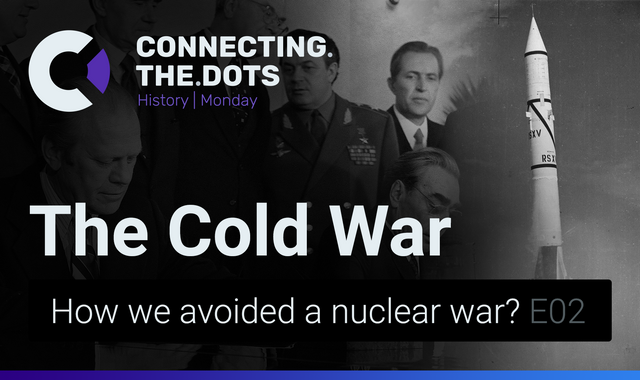
The recent rhetoric of calling current events as the Second Cold War or even calls by the U.S. President Donald Trump for a new arms race between two superpowers the United States and Russia and Russian demonstrations of hypersonic missiles, raises serious questions like: „Did we lost our minds?“, „ Do we understand what the fcuk we are doing?“, „Haven‘t we learned?“ etc etc.
People tend to take what they got for granted and current situation, as imperfect as it is, was build on countless mistakes and endless oceans of blood of the giants. We are not as safe as we think and if we cherish what we got, we have to embrace and protect a few treaties which let us live without a fear of being nuked any day.
I won‘t talk about nuclear bombs itself, as for that I would love to go into physics, but that would make this article simply too long. Instead, I‘ll focus on delivery systems, mainly, ballistic missiles and treaties signed during and post-Cold War which limits the arms race today.
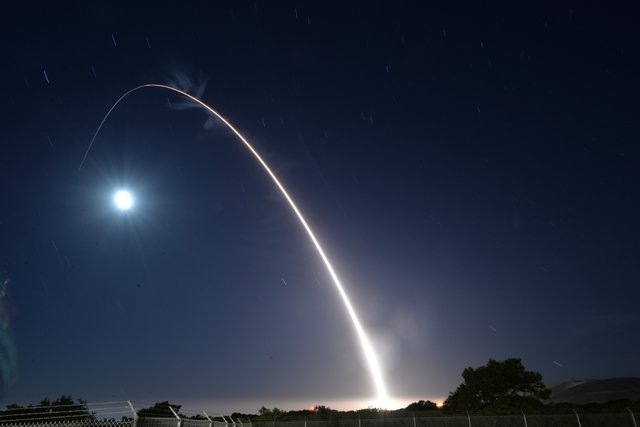
An unarmed U.S. Air Force Minuteman III intercontinental ballistic missile launches during an operational test May 3, 2017
Source: Flickr
Ballistic missile
A ballistic missile is a type of missile which is powered and directed only for a short time after it‘s launch and falls under the target affected by the natural force of gravity. This technology during the Cold War years seemed to be superior to its alternative – cruise missiles.
Cruise missile
A cruise missile is a low-flying missile with propulsion and a constant speed. It has wings and is guided to its target by an onboard computer. Even though with modern technology cruise missiles proved to be highly accurate, back in the Cold War days they seemed to be not as accurate and reliable as ballistic missiles. During the Cold War, cruise missiles were preferred over ballistic ones only for several years after World War II.
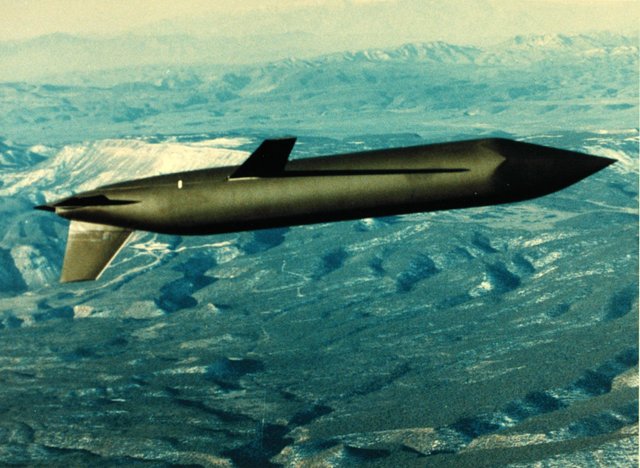
AGM-129 ACM Cruise Missile
Source: Flickr
Types of ballistic missiles
Ballistic missiles are categorized by the distance they can travel. Usually, they are divided into three groups: short range (100 to 1,000 km / 60 to 320 miles), intermediate (1,000 to 5,500 km / 320 to 3,400 miles) and the most deadly ones – inter-continental (minimum range of 5,500 km / 3,400 miles). Some organizations add medium-range ballistic missiles to this with a list defined with a maximum range of 1,000 to 3,000 km (320 to 1865 miles).
ICBM – Inter-continental ballistic missiles
Inter-continental ballistic missiles are capable to reach a target in the enemy‘s territory and destroy it. ICBM has a minimum range of 5,500 km (3,400 miles) and was primarily designed to carry nuclear weapons, nevertheless, it could carry other weapons of mass-destruction: biological and chemical weapons. Even worse, these missiles could deliver nuclear weapons in such a manner that was virtually immune to any defensive systems.
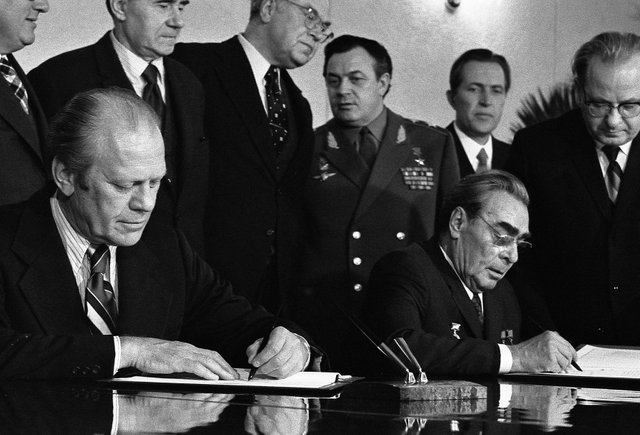
American President Gerald Ford and Soviet General Secretary Leonid Brezhnev sign a Joint Communiqué following talks on the limitation of strategic offensive arms in Vladivostok on November 24, 1974.
Source: Wiki
Levels of ICBM launchers were frozen after SALT treaty in 1972 and was limited further in 1979 and 1991 by SALT II and START treaties respectively. Currently, only 5 countries have operational ICBM systems are United States, Russia, China, India and a newest cool kid in the block – North Korea. Israel has also tested ICBMs, but it is unclear if they could actually deploy and launch it.
SALT – Strategic Arms Limitation Talks
Talks were suggested in 1967 by U.S. President Lyndon B, Johnson, agreed in 1968, started in 1969 and signed in 1972, which froze the construction of ICBM. It was followed by further SALT II talks (1972-1979) helped even to reduce the number of nuclear warheads held by the U.S. and the Soviet Union. SALT II talks were never ratified by the U.S. Senate as the tension between both sides increased after USSR invading Afghanistan, nevertheless both sides voluntarily honored terms of the agreement until 1986 when Reagan administration „withdrew“ after accusing the Soviets of „violating“ the pact.
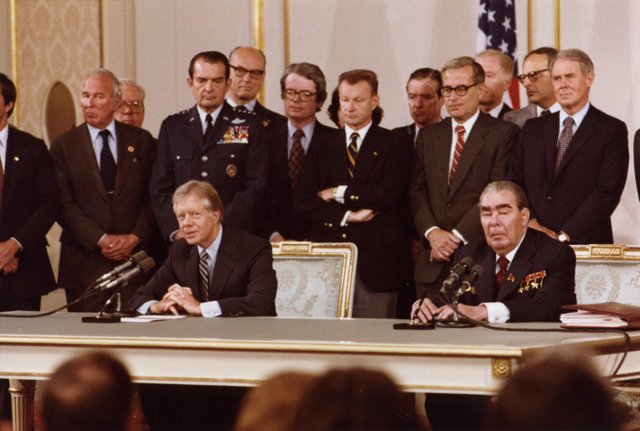
President Carter and Soviet General Secretary Leonid Brezhnev sign the Strategic Arms Limitation Talks (SALT II) treaty. Washington, DC. June 16, 1979.
Source: Flickr
While SALT II focused on more specific regulations on the different missiles and has limited both sides to no more than 2,400 missile weapons systems, the most important parts of SALT I was ABM treaty and Interim Agreement on the Limitation of Strategic Offensive Arms.
ABM (Anti-ballistic missile) treaty
Anti-ballistic missile treaty regulated antiballistic missiles that could theoretically be used to destroy the incoming enemy missile. This treaty limited deployment of such systems only to a single area with up to 100 interceptor missiles. With ABM treaty each side could defend only a small part of their territory, thus this kept both sides afraid to attack each other‘s strategic forces. It was ratified by U.S. Senate on Aug. 3, 1972.
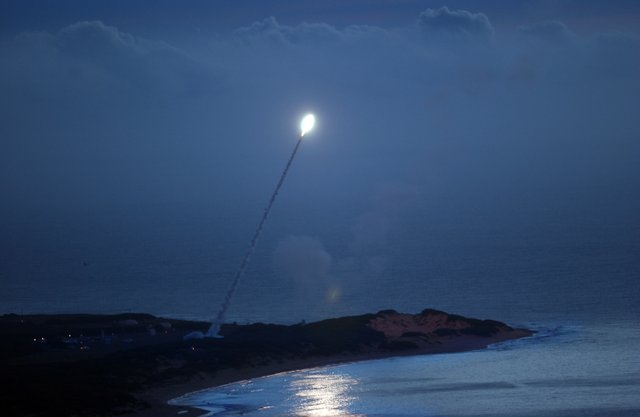
Nov. 6, 2007 - A target is launched on November 6, 2007 enroute to an intercept as part of a Missile Defense Agency test of the Sea-based capability under development, yet tactically certified and deployed with the U.S. Navy.
Source: Flickr
Interim Agreement on the Limitation of Strategic Offensive Arms
Interim Agreement froze the number of ICBMs and SLBMs (Submarine-launched ballistic missile) of the U.S. and the Soviet Union at the current level for five years to get some extra time on more specific SALT II negotiation talks.
The U.S. ballistic missile development
The interest in ballistic missiles of both Cold War sides aroused after the success of German scientists in late World War II when the V-2 rocket was launched and proved that it could reach its target without any effective defensive interference.
After the war, both sides tried to collect the remaining materials of the V-2 program, including Wehner von Braum and his team of German engineers and scientists. In 1945, the U.S. Secretary of Senate approved the transfer of von Braun and his specialists to the United States, which provided the initial core of the U.S. ballistic missile program. And yeah... This is the same Wernher von Braun, a member of Nazi party in whose factories brutal slave labor occurred in the late World War II when a shortage of labor developed in Nazi Germany. Wernher von Braun was accused of being seen standing near the cranes with hanged people by chains, which was a way to scare and „motivate“ slaves.
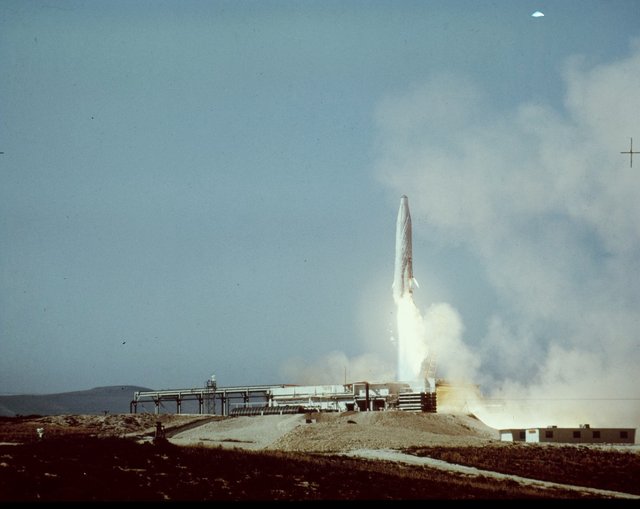
Atlas ICBM Launch
Source: Flickr
The Atlas ICBM project
Atlas missiles were the first American ICBMs, though it was poorly funded until 1954 when Atomic Energy Commission achieved a breakthrough in nuclear weapons, making them smaller and lighter, hence easier to transport. This year the Atlas project gained top priority status and in 1955 Dwight D. Eisenhower elevated it to the highest national priority. SM-65 Atlas had a maximum range of 10,138 km (6,300 miles).
Titan ICBM
Atlas was not the only ICBM the U.S. had developed, Titan missiles had an even bigger range and were developed as an alternative in case the Atlas project proved to be unsuccessful. These missiles had a range of up to 16,000 km (9940 miles), but it lacked the ability to be launched from a silo, hence was vulnerable to the Soviet Union preemptive strikes.
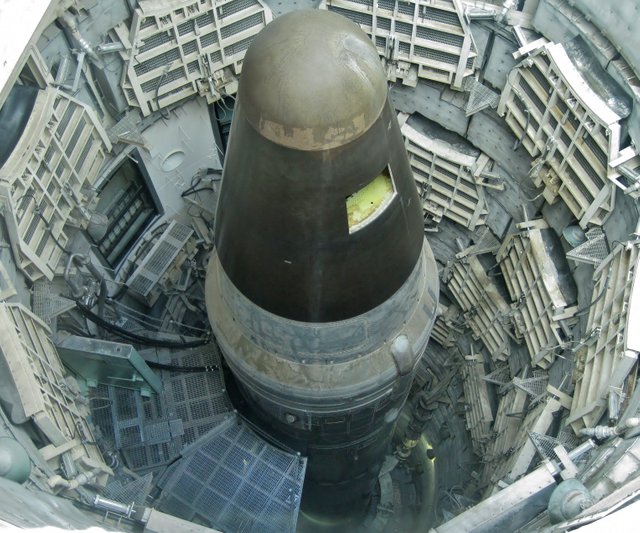
Air Force Facility Missile Site 8 (571-7) Military Reservation
Source: Flickr
The U.S. deployment of ICBMs
Plans of ICBMs deployment changed as an arena of the Cold War developed. The original plan, approved by Eisenhower in 1957, for 40 Atlas and 40 Titan missiles, but after the launch of Sputnik, later that year forced the U.S to adopt an „emergency plan“ to deploy the first Atlas missiles in June 1959 with 123 ICBMs. These had to consist nice Atlas squadrons and four Titan operational by March 1963. But the reality was that the United States had 13 Atlas and 6 Titan squadrons by the end of 1961.
Minuteman ICBM
Both Titan and Atlas ICBMs ran by liquid oxygen and kerosene fuel which posed several problems. The fuel was dangerous and corrosive which made missile silos expensive and difficult to maintain. To overcome these obstacles, the U.S., in the late 1950s, begun a research on a missile ran by a solid fuel – Minuteman ICBM. The missile was deployed in the early 1960s and quickly replace ICBMs ran by liquid fuels. At its peak, 1,000 Minuteman ICBMs were active during the Cold War years.
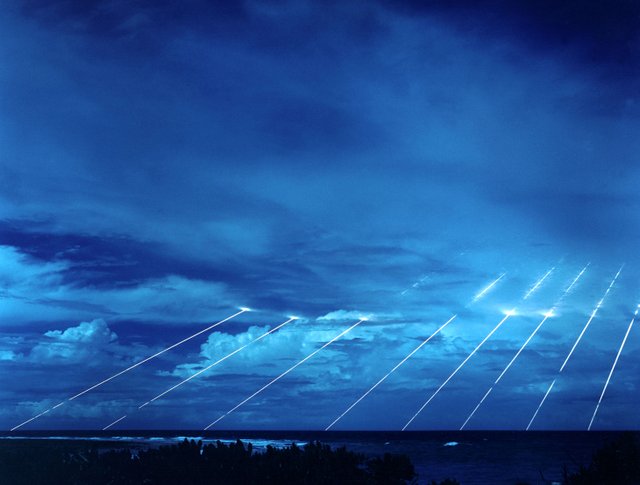
Time exposure shot of testing of the Peacekeeper re-entry vehicles at the Kwajalein Atoll, all eight fired from one missile.
Source:Wiki
MX Peacekeeper ICBM
The concept of the final generation of American ICBMs called „MX Peacekeeper ICBM“, was mobile deployment missiles ran by solid fuels. The idea of it was to build Peacekeeper missiles in a base with a huge „racetrack“, where they could be randomly dislocated, thus making almost impossible for the Soviets to know their exact location. While it was seriously considered, in the end, due to high costs and vast land requirements, it was decided in favor of fixed launch sites.
Under terms of SALT II treaty, MX Peacekeeper was taken out of the active service and to this day the only U.S. operational ICBMs are third generation Minuteman with a range of 13,000 km (8077 miles).
The Soviet Union ballistic missile development
Although by the end of 1959 the Soviet Union had tactical ballistic missiles R-1 and R-2, medium-rare ballistic missile R-5 and intercontinental ballistic missile R-7, they had flaws. All of those missiles were designed by Sergey Korolev and used liquid oxygen as an oxidizer. Complex specifications of liquid oxygen production, storage and transportation greatly increased the required time for the missile launch preparation. Thus, making fast and reliable launch of the missile was to say – impossible.
Mikhail Yangel‘s initiative to design medium-rare ballistic missiles, which fuel components didn‘t require low storage temperature, was actively supported by the military. The newly designed missile got the code name 8k63 or R-12. The reconnaissance of NATO block gave this new Soviet missile a name „SS-4 Sandal“. The first R-12 missile launch was carried out from Kapustin Jar, rocket launch, and development site on 22 June 1957.
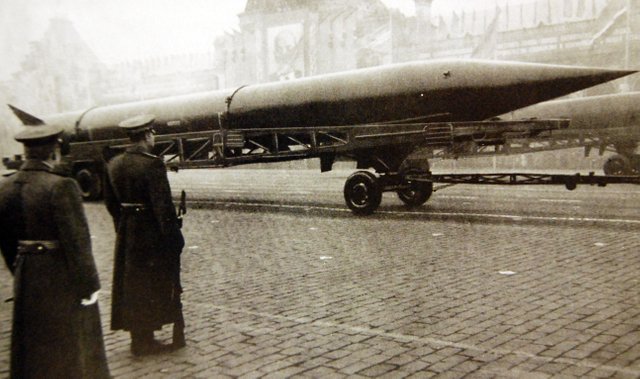
Cold War – Soviet Activities. Intercontinental missiles. A few weeks of the parade the 40th anniversary of the roughly October Socialist Revolution.
Source: Flickr
These type of missiles could be quickly and widely used due to its relative simplicity and low cost. The capacities of implementation of mass Soviet mid-range ballistic missiles, equipped with Megaton power nuclear warheads, production was best described by their leader Nikita Khrushchev: „We are producing missiles like sausages“. And there is a lot of truth in that, the serial production of R-12 reached around 2,300 units throughout these years. The mass production of these missiles, simple and mobile launchers and reliable operation of all missile components has allowed this simple enough missile practically to stay used for the longest in the whole missile armament. These missiles were finally abandoned only in 1989 – two years after signing Intermediate-range nuclear forces treaty, under which, both U.S. and Soviet Union had to destroy their intermediate and short-range missiles.
INF (Intermediate-Range Nuclear Forces) treaty
INF treaty was a nuclear arms control accord reached by the United States and the Soviet Union in 1987 in which both sides agreed to destroy their arsenal of short to intermediate range land-based missiles capable of carrying nuclear warheads. It was the first agreement on which both sides agreed to destroy the entire arsenal of certain weapon systems.
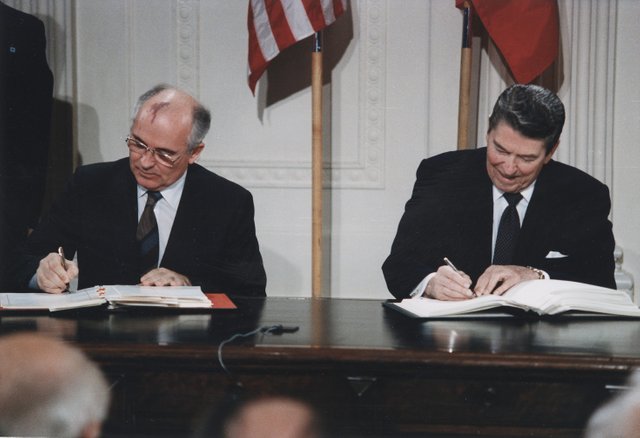
President Reagan and General Secretary Gorbachev signing the INF Treaty.
Source:Wiki
INF negotiations started in October 1980, just three years after the first RT-21Ms (SS-20s) were deployed in the Soviet Union. These intermediate missiles could strike any target in Western Europe in less than 10 minutes. Three years after negotiation start, under the pressure of its western European allies, the U.S. deployed to of their own intermediate-range weapon systems in Europe, which could strike Moscow in less than 10 minutes. Under the pressure of possible attack, INF treaty was signed in Washington, D.C., on December 8, 1987, by the U.S. president Ronald Reagan and Soviet General Secretary Mikhail Gorbachev. It was ratified by the U.S. Senate and the Supreme Soviet the next year.
Post-Cold War talks and START (Strategic Arms Reduction Talks) Treaty
START I arms control negotiations was a successor to SALT negotiations of the 1970s. In 1982, U.S. President Ronald Reagan renamed the talks between two superpowers and proposed to negotiate not on mere limitations, but on radical reductions of nuclear bomb carrying weapons. In 1983 the USSR quit the talks in protest of the U.S. deployment of Intermediate-range ballistic missiles in Western Europe. The START talks resumed in 1985 and were signed by the President of the United States George H.W. Bush and Soviet leader Mikhail Gorbachev in 1991.
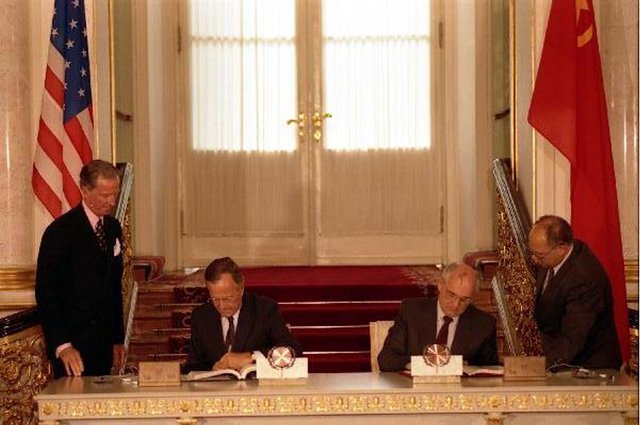
On 31 July 1991, the US President, George Bush (sitting on the left), and General Secretary of the Communist Party of the Soviet Union, Mikhail Gorbachev (sitting on the right), sign the START I Agreement for the mutual elimination of the two countries’ strategic nuclear weapons.
Source:Wiki
This treaty was easily ratified by the U.S. Senate, but it encountered difficulties when the Soviet Union collapsed in 1991 which left four different countries with nuclear weapons – Belarus, Kazakhstan, Ukraine, and Russia. In May 1992 the Lisbon Protocol was signed, which allowed all parties to take part in the START I treaty. In exchange for country sovereignty, security guarantee, financial assistance, and compensation Ukraine, Kazakhstan, and Belarus had to either destroy or hand their nuclear arms to Russia.
In 2014 Russian Federation annexed Crimea region of Ukraine as political winds inside of the later started to shift towards the West. Crimean peninsula for political and military reasons is a crucial geopolitical point to Russian Federation and simply cannot be allowed to be controlled by the enemy. Nevertheless, the by annexing Crimea, Russia heavily offended the Lisbon Protocol.
START I treaty set limitations that both the United States and Russia by 1999 would be permitted a total of 7,950 warheads on a maximum of 1,900 delivery vehicles. This new limit was a huge improvement as the levels established before were 11,000 nuclear warheads for each side.
The last stage of the treaty was to be completed by the end of 2001 when both sides reduced their nuclear warheads to 6,000 units and nuclear delivery vehicles to 1,600. Both sides did as they agreed, but the START I treaty expired in 2009.
START II treaty
START II was arms control talks for the further reduction of nuclear weapons. Under this treaty, both sides had to reduce their nuclear arsenal to 3,800-4,250 by 2000 and to 3,000-3,500 by 2003. Even though the United States and the Soviet Union agreed on the outlines of START I, START II was never ratified mainly due to Russian irritation with the United States over their attitude toward ABM treaty and Western policies in the Persian Gulf and the Balkans. Ultimately Russia linked failure of the START II treaty to the U.S. withdrawal from ABM treaty by George W. Bush administration in 2002.
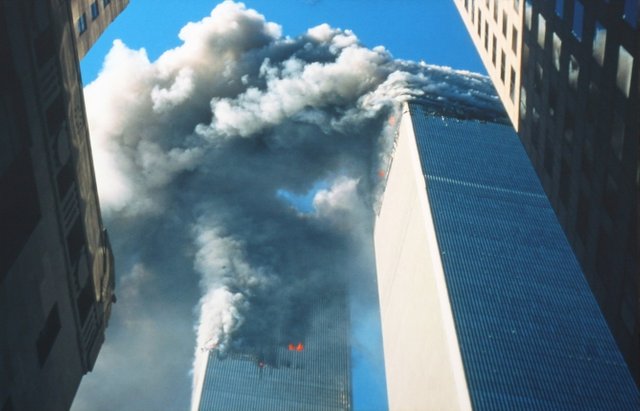
10:28:24 a.m. on September 11th, 2001 was the precise second that photojournalist Bill Biggart took the final shot of his life. He took his last breath moments later when the North Tower of the World Trade Center collapsed upon him.
Source:Flickr
The U.S. argument for the withdrawal was that they need these defensive systems to protect their country from rogue states and terrorist organizations. With 2001 attacks on the United States, partly, this makes sense, but it further irradiated Russia with their announcement of deploying such anti-ballistic missile systems in Poland and the Czech Republic, with an argument that it was deployed in order to protect the west from Iran Nuclear attacks. To Russia, this made no sense as the U.S. refused to deploy such systems in Turkey or Azerbaijan as Russia suggested.
START III treaty
Because of the Duma‘s objection that proposed cuts of nuclear weapons were not deep enough, talks on arms control with even reduction were agreed in 1997 by the U.S. president Bill Clinton and Russian president Boris Yeltsin. START III, which would bring each side to 2,000-2,500 warheads by Dec. 31, 2007. The talks sank after the U.S. withdrew from the ABM treaty.
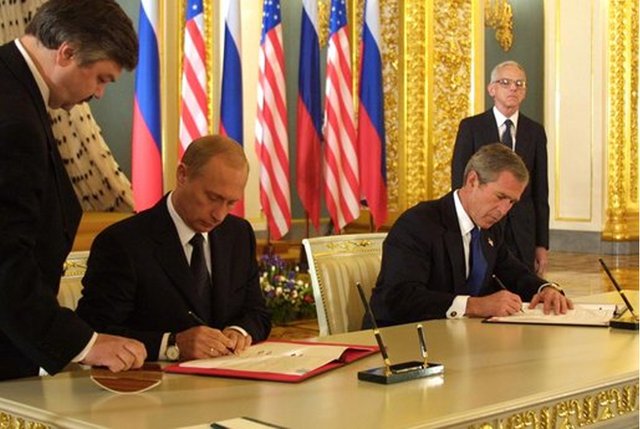
President of Russia Vladimir Putin and President of the United States George W. Bush sign the Strategic Offensive Reductions Treaty in Moscow on 24 May 2002.
Source:Wiki
Moscow Treaty or SORT (Strategic Offensive Reductions)
A different treaty, called SORT, was signed by Russian President Vladimir Putin and U.S. President George W. Bush during those times. This treaty was ratified by both governments without any difficulty. While SORT required both powers to reduce their nuclear weapons to between 1,700 and 2,200 warheads by Dec. 31, 2012, it did not require the destruction of those warheads and instead, it could be simply to be stored and further this treaty did not require any eliminations of nuclear warhead delivery systems.
Moscow treaty was implemented without any difficulties, though it was uncertain what will happen if both sides wouldn‘t come to any replacement for the START I treaty until 2009 when it was scheduled to end. Further talks were difficult due to the United States occupation of Iraq, plans of deploying anti-ballistic missile defense systems into Eastern Europe and Russia‘s war with Georgia.
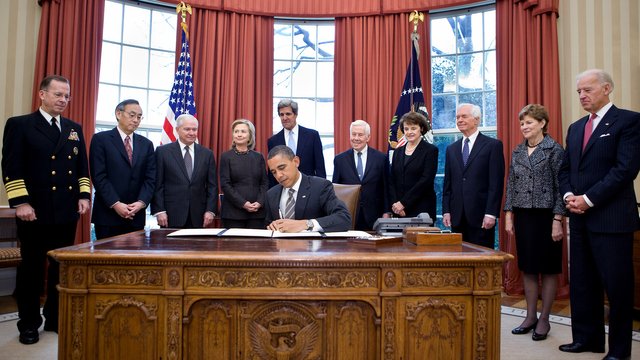
President Barack Obama signs the New START Treaty, February 2, 2011.
Source:Wiki
New START
In 2009 new winds at both sides political landscapes allowed a possibility of a new agreement between the United States and Russia. The U.S. Pres. Barack Obama and Russian Pres. Dmitry Medvedev agreed to work out a new treaty by the end of December which proved to be more difficult as expected and only by April 2010 an agreement was reached.
The New START treaty requires both sides to reduce their strategic nuclear warheads to 1,550 and delivery systems to 800 (deployed and undeployed), with maximum 700 could be deployed at once and the rest to be used for training without any missiles equipped.
Current situation
Allegedly Trump attacked New START treaty between the United States and Russia on his phone call to Vladimir Putin on February 9, 2017.
.jpg)
Vladimir Putin and Donald Trump at the 2017 G-20 Hamburg Summit
Source:Wiki
In 2018 Russia declared in possession of a hypersonic cruise missile capable of avoiding any defensive systems of the Western Allies. They even released a video of such a missile trajectory reaching its target in Florida. The Russian message is clear to the U.S. and Vladimir Putin stated that this should force the United States to respect Russian federation positions and conditions on the negotiation table.
Officially both the United States and China are in development of such a missile.
After this demonstration, the U.S. Senate seems like not in the mood to resume NEW START treaty in 2021 and some Republicans even suggesting withdrawing from it, because Russians broke INF by deploying prohibited cruise intermediate-range missile to Southern Russia. Russians don‘t want to talk about INF if Americans don‘t renegotiate the ABM treaty.
.jpg)
ICBMs can be deployed from transporter erector launchers (TEL), such as the Russian RT-2PM2 Topol-M
Source:Wiki
The impact of ballistic missiles armed with nuclear warheads
There were many more missile projects, but the point was only to show the progress, the importance and the effort put in into these missiles development, not the technical side of the weapons or the whole history. The development of these ballistic missiles together with the advancement of nuclear is a great threat to our civilization, it is so great that in some sense one could argue that this threat is the reason for peace between great powers of the World.
Importance of the treaties
And the reason for that was all the treaties signed by superpowers. All of these treaties mentioned in this article and many more have a great importance for world peace. This is why it is so afraid that more countries would develop this technology as it is not sure if they are going to play the rules. It is very unlikely that a country like North Korea or Iran will ever going to be able to produce enough warheads to cause as something as tragic as nuclear winter, or has enough territory for it to be nuked to this level, still, the nuclear war would be the most deadly event in the history of humankind.
So anyone thinking that pushing narrative for a conflict between Russia and United States or any other two superpowers is a good idea should think again because they definitely didn‘t think it through well enough the first time. There is an old saying of the Cold War:
„If you don‘t take care of nuclear weapons, the nuclear weapons will take care of you.“
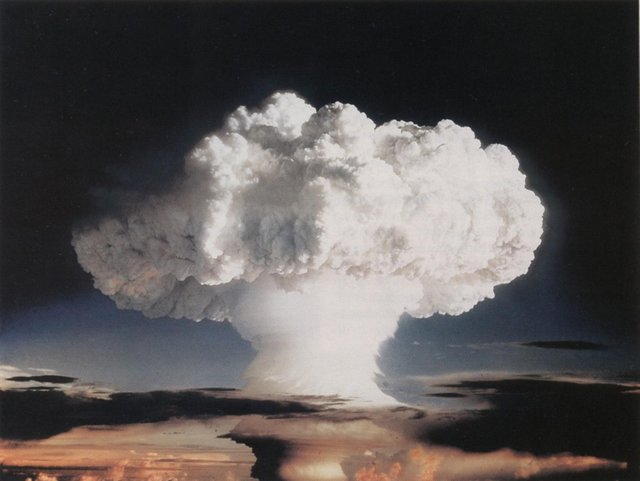
"Ivy Mike" atmospheric nuclear test - November 1952
Source:Flickr

This article is a part of the bigger historical series about the Cold War. Follow me for a new history post on every Monday.
*I've moved from Sunday to Monday, because it became clear to me that sometimes due to traveling I'll simply just won't have enough time to complete the post on Sunday.
Inspired by the Cold War Museum at Plokstine Missile Base in Lithuania
Author: Mantas Ališauskas
Photography: Taken and linked to various sources from Flickr and Wiki
Design: Mantas Ališauskas
Website: http://www.ctdots.eu
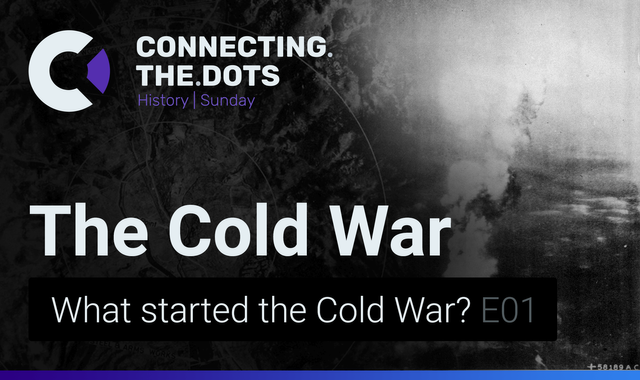
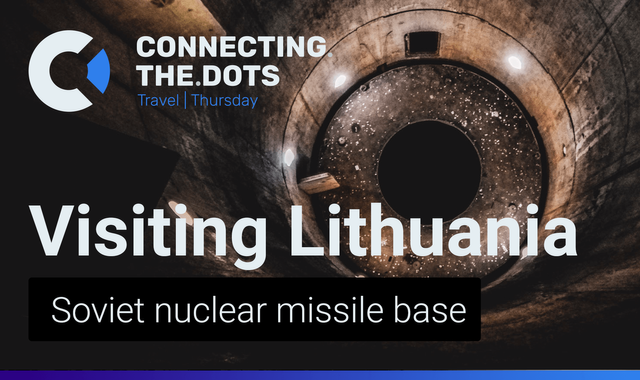
You got a 22.25% Upvote and Resteem from @ebargains, as well as upvotes from our curation trail followers!
If you are looking to earn a passive no hassle return on your Steem Power, delegate your SP to @ebargains by clicking on one of the ready to delegate links:
50SP | 100SP | 250SP | 500SP | 1000SP | 5000SP | Custom Amount
You will earn 90% of the voting service's earnings based on your delegated SP's prorated share of the service's SP pool daily! That is up to 38.5% APR! You can also undelegate at anytime.
We are also a very profitable curation trail leader on https://steemauto.com/. Follow @ebargains today and earn more on curation rewards!
I think it will be soon that one bomb could destroy the whole planet
Even though the idea of doomsday device like that sounds ridiculous, somehow, that wouldn't surprise me:D especially with current mindset: bigger - better.
Congratulations! Your post has been selected as a daily Steemit truffle! It is listed on rank 8 of all contributions awarded today. You can find the TOP DAILY TRUFFLE PICKS HERE.
I upvoted your contribution because to my mind your post is at least 46 SBD worth and should receive 127 votes. It's now up to the lovely Steemit community to make this come true.
I am
TrufflePig, an Artificial Intelligence Bot that helps minnows and content curators using Machine Learning. If you are curious how I select content, you can find an explanation here!Have a nice day and sincerely yours,

TrufflePigHello! Thank you for noticing my post, I really put a lot of work into this one and even if I don't make some SBD I really appreciate every comment or mention I get:)
hello my friend really your post has huge info and interesting , you posted history in the world, brotherhood is the bid-bot with 12000 sp you can send min 0.15 to 0.4 max sbd or steem to promote your post

Thanks for reaching me out, I'll try out your service and see how it works, brothers:)
Rich in historical fact.
Thank you, I consider myself a pragmatic, therefore I really believe that we need to learn form our mistakes:)
You are right.
I wish more people could see it as we do:)
These weapons are magnificent but at the same time scary. I just hope that they don't have to use these weapons.
Yeah, I agree. I hope they lie somewhere without being used and reminding us of what we are capable of.
You received a 35.29% upvote from @brotherhood thanks to @ctdots!,
)
Delegate to Bot and Get High Return Fix 100% earning return,
bidders will always win something and it will adapt to distribute all the 100% upvote ,now we reached to 12000 SP and recommend. send the 0.15 to 0.4 sbd or steem.
This post was upvoted and resteemed by @resteemr!
Thank you for using @resteemr.
@resteemr is a low price resteem service.
Check what @resteemr can do for you. Introduction of resteemr.